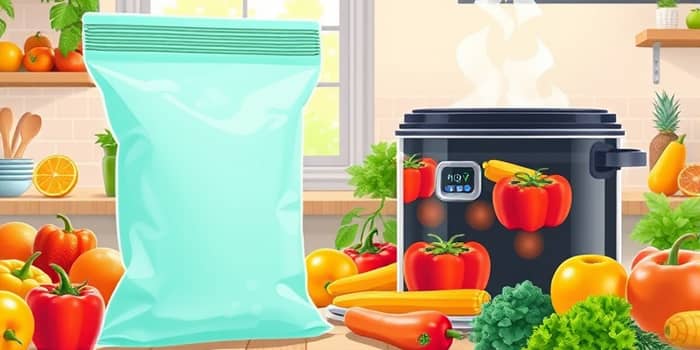Every year, households around the globe contribute to the mounting tide of plastic pollution. As we become increasingly aware of our environmental footprint, the humble storage bag has emerged as a surprising hero in the battle against waste. It’s time to rethink how we store food, protect our health, and preserve our planet’s future.
How Silicone Bags Solve Environmental Issues
Single-use plastic bags have been a staple in kitchens for decades, yet their convenience comes at a devastating cost. Over 300 million tons of plastic waste clog landfills and pollute oceans annually, threatening wildlife and ecosystems. In stark contrast, silicone storage bags offer a dramatically greener solution.
Each high-quality silicone bag can replace over 1,500 plastic bags in its lifespan. This translates to reducing annual plastic waste by 11 pounds per household, diverting thousands of plastic bags from landfills and waterways. While manufacturing silicone does require more initial energy than producing disposable plastic, its decades-long durability and reusability more than compensate for that footprint. Many brands also partner with renewable energy projects, slashing net carbon emissions even further.
By choosing silicone, you join a growing community of conscious consumers turning the tide on pollution. Every time you reach for a reusable bag, you cast a vote for a cleaner, healthier planet.
Health and Food Safety Comparisons
Concern about harmful chemicals leaching into food is justified. Traditional plastic bags contain BPA, phthalates, and other additives linked to hormonal disruption and long-term health risks. Silicone storage bags, however, are crafted from inert food-grade material that remains stable under diverse conditions.
Silicone is non-toxic BPA-free and phthalate-free, certified by agencies like the FDA and LFGB. It won’t break down or release microplastics, even in acidic environments like tomato sauce or citrus marinades. In fact, silicone boasts an impressive temperature range from −40°F to 450°F, making it safe for freezing, microwaving, boiling, baking, and sous vide cooking. Compared to plastics that can emit toxins above 170°F, silicone offers a reliable shield for your family’s health.
Cost Over Time: Is the Upfront Price Worth It?
At first glance, a silicone bag’s price tag—typically $6 to $8 per bag—may seem steep compared to a handful of-cent plastic bag. Yet the true value reveals itself through repeated daily use. A single silicone bag lasts for years, handling hundreds of cycles without cracking or losing seal integrity.
Most consumers find that their silicone investment pay for themselves after dozens of uses, often within just two months in an average household. Over the bag’s lifetime, the cost per use drops to pennies—far outpacing disposable options. You’ll save on repeated trips to the store for plastic replacements and reduce clutter in your home. Long-term savings also come from preventing food spoilage, thanks to an airtight seal that keeps produce fresh up to twice as long.
Real-World Usage: Versatility and Convenience
One of silicone storage bags’ greatest strengths is their adaptability. From marinating meats to organizing recipe ingredients, their flexible design accommodates solids and liquids alike. The airtight seal prevents leaks, making them ideal for travel, camping, and lunchboxes.
- Freezer storage without cracking or freezer burn
- Microwave reheating directly in the bag
- Oven baking or sous vide cooking at precise temperatures
- Easy cleanup thanks to a dishwasher-safe and leak-proof design
Silicone’s resilience means it won’t absorb odors or stains, and it preserves the texture and flavor of your food. Its lightweight, flexible form allows you to roll or fold bags for compact storage, leaving more room in your cabinets and freezer.
Addressing Potential Drawbacks and Solutions
No product is without its challenges. Silicone storage bags may take up more space than flattened plastic, and the initial wash cycle requires a bit more time than discarding a disposable bag. Yet these hurdles are easy to overcome with a few simple strategies.
- Flatten and stack bags to minimize bulk in your freezer or pantry.
- Label each bag with date and contents using a reusable marker or tag.
- Maintain a rotation system: use older items first and refold clean bags immediately.
It’s also crucial to choose high-quality, certified products. Look for FDA or LFGB approval to ensure your silicone bag meets rigorous safety standards. Some brands even offer recycling or take-back programs for worn-out bags, ensuring the lifecycle remains circular and sustainable.
Summary Comparison Table
Conclusion: Embracing a Sustainable Future
Silicone storage bags represent more than just a kitchen upgrade—they embody a shift toward mindful consumption, better health, and environmental stewardship. By making the switch, you reduce plastic pollution, safeguard your family from toxins, and enjoy lasting, versatile storage for every cooking adventure.
Imagine a future where landfills shrink, oceans clear, and our daily choices reflect care for people and the planet. Small actions, like selecting a silicone bag over a disposable one, cascade into powerful change. In every way, silicone storage bags are not just better—they are the new standard for conscious living.
References
- https://www.cuisiprousa.com/blogs/news/5-ways-silicone-reusable-bags-can-make-your-life-easier-in-the-kitchen
- https://www.oxo.com/blog/cooking-and-baking/reusable-silicone-food-bags-benefits
- https://ecolunchboxes.com/pages/silicone-people-planet
- https://thefamilyfreezer.com/2019/09/25/reusable-silicone-bags-vs-plastic-freezer-bags/
- https://www.theexaminernews.com/buying-guides/silicone-food-storage-bags/
- https://elkanah.store/blogs/news/the-environmental-impact-of-reusable-silicone-bags-a-comprehensive-analysis
- https://aterimber.com/reusable-silicone-bags/
- https://tidyboard.com/blogs/news/silicone-food-storage-benefits










